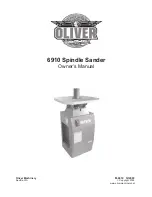
> Do not sand pieces of material that are too small to be safely supported.
> Avoid awkward hand positions where a sudden slip could cause a hand
to move into the sanding belt or disc.
> When sanding a large workpiece, provide additional support at table height.
> Do not sand with the workpiece unsupported. Support the workpiece with the
backstop or table. The only exception is curved work performed on the outer
sanding drum.
> Always remove scrap pieces and other objects from the table, backstop or belt
before turning the machine “ON.”
> Never perform layout, assembly or set-up work on the table while the sander is
operating.
> Always turn the machine “OFF” and disconnect the cord from the power source
before installing or removing accessories.
> Never leave the machine work area when the power is “ON” or before
the machine has come to a complete stop.
> Never use solvents to clean plastic parts. Solvents could possibly dissolve or
otherwise damage the material. Only a soft damp cloth should be used to clean
plastic parts.
> Should any part of your sander be missing, damaged, or fail in any way, or any
electrical components fail to perform properly, shut off switch and remove plug
from power supply outlet. Replace missing, damaged or failed parts before
resuming operation.
> The use of attachments and accessories not recommended by may result in the
risk of injuries.
WARNING! Some dust particles created by power sanding, sawing,
grinding, drill and other construction jobs contain chemicals known to
cause cancer, birth defects or other reproductive harm. Some examples of
these chemicals are:
• Lead from lead-based paints.
• Crystalline silica from bricks and cement and other masonry products.
• Arsenic and chromium from chemically treated lumber.
Your risk from these exposures varies, depending upon how often you do this type
of work. To reduce your exposure to these chemicals:
• Work in a well-ventilated area.
• Work with approved safety equipment, such as those dust masks that are specially
designed to filter microscopic particles.
11
TTB546BTS
by TITAN
Technical and legal
information
Getting
started...
GB
IE












































